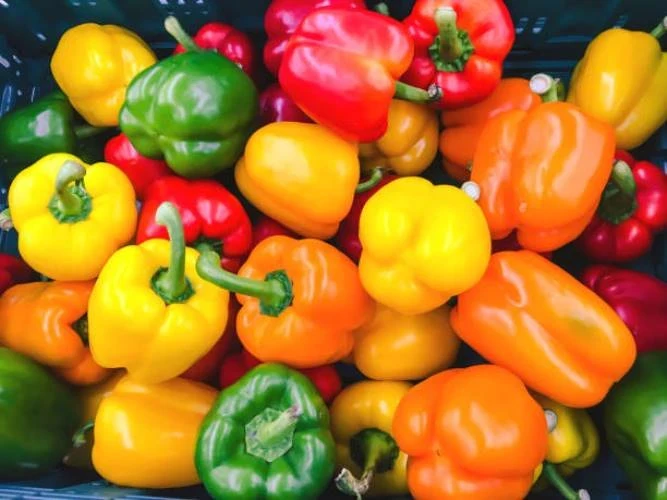Not only is it an ingredient for a weight loss meal, the vitamins in bell peppers also help protect the heart, improve eyesight, help you sleep well, improve digestion, brighten the skin and reduce hair loss.

Bell peppers are a popular ingredient used in many dishes, especially salads. But did you know that they are not a vegetable but actually a fruit?
Botanically, bell peppers are classified as berries, which are fleshy and seeded fruits.
Bell peppers belong to the group of less spicy peppers (same as sweet peppers) so they are also called sweet peppers. This fruit does not produce capsaicin, a lipophilic compound that causes the hot sensation for users like other types of peppers.
Bell peppers are low in calories but rich in vitamins that are good for the body such as vitamin C, vitamin A, vitamin E, vitamin K, folate (vitamin B9), potassium, magnesium..., making them a great addition to a healthy and balanced diet.
Bell peppers come in a variety of colors, the most common being red, yellow, and green. Less common are orange, brown, white, and purple varieties.
According to nutritionist Danielle Crumble Smith (USA), bell peppers of different colors will contain different amounts of nutrients, so depending on the color of each bell pepper, there are different ways to prepare it to take full advantage of the nutrients of this fruit.
According to nutritionist Danielle Crumble Smith, red bell peppers contain the most nutrients because they take longer to ripen, and are also higher in vitamins and antioxidants than other colored bell peppers.
Red bell peppers contain a lot of vitamin C (75% of red pepper's nutrition is vitamin C, if processed, 100g of red pepper will provide the body with about 100mg of vitamin C).

The vitamin A content in red bell peppers is also higher due to the presence of beta-carotene, which together with lycopene gives red bell peppers their color.
Meanwhile, green bell peppers have a slightly pungent taste, less sugar and carbohydrate content, but contain a lot of vitamin A in the form of beta carotene, which is effective in beautifying, anti-oxidizing, preventing cancer, good for eyesight, and increasing resistance. Every 100g of green bell peppers will contain about 3.5mg of beta carotene and because it is difficult to eat raw due to its pungent taste, green peppers are often cooked.
Yellow and orange peppers are somewhere in between red and green in flavor and nutritional value. Generally, the darker the pepper, the more nutrients it contains, says expert Danielle Crumble Smith.
Enhance eyesight
Bell peppers contain a lot of vitamin A, which is an essential substance that helps improve eyesight. According to research, in one serving, this type of pepper will provide about 75% of the body's necessary vitamin A content to help improve and develop vision, support night vision and prevent night blindness.
Orange, red and especially green bell peppers contain a lot of zeaxanthin. This is an essential substance that helps protect the macula from the effects of blue light on the eyes.
Supplement and prevent anemia
Bell peppers contain iron - an essential substance that helps supplement and prevent anemia in the body. In addition, vitamin C in red bell peppers also helps the body fight oxidation and helps the intestines increase iron absorption.
Protect heart health
The strong antioxidants in bell peppers will neutralize and prevent the effects of free radicals that damage cells in the body, reduce bad cholesterol in the blood. Thereby, limiting the risk of developing chronic diseases such as cancer, type 2 diabetes, heart disease, and stroke.
On the other hand, the abundant amount of phytonutrients in bell peppers will reduce the risk of cardiovascular disease, good for people with high blood pressure, help reduce inflammation, detoxify, increase immunity and metabolism of hormones; help reduce symptoms of shortness of breath and relax the respiratory tract for asthma patients to reduce the severity and number of attacks.
Helps sleep well
Thanks to the combination of vitamin B6 and magnesium, bell peppers help reduce nervous tension and anxiety, and strengthen the body's natural immune system.
In addition, vitamin B6 contributes to the production of melatonin for better sleep quality, helping to balance the body's "biological clock".
For women, bell peppers also help reduce premenstrual symptoms such as pain, fatigue, and mood swings.

Good for digestion, supports weight loss
Bell peppers contain no cholesterol, are low in fat, low in calories, and have the ability to generate heat and increase the body's metabolic rate, helping you burn more calories to lose weight.
In addition, unlike other types of peppers containing capsaicin that cause heat in the body, bell peppers only generate heat at the right level to increase metabolism, so they do not increase heart rate or blood pressure.
The abundant amount of fiber promotes intestinal motility, stimulates digestion, protects the intestines from harmful bacteria, prevents the risk of colon cancer, thereby treating irritable bowel syndrome and constipation.
Brightens skin, reduces hair loss
Because of its powerful antioxidant properties and vitamin C that helps promote collagen formation, your skin will be improved to be firm and healthy. Moreover, the phytonutrients in bell peppers help treat dark spots, acne and skin infections effectively.
Eating bell peppers every day also helps reduce hair loss, making hair stronger and smoother.
Bell peppers contain many nutrients and the best way to absorb them is to eat them raw like fresh fruit or make a salad with vegetables for a weight loss breakfast.
There are also many recipes for bell peppers to make delicious dishes such as stir-fried pork with bell peppers or spicy diced chicken with bell peppers for lunch; sweet and sour bell peppers, chopped potatoes stir-fried with bell peppers for dinner.
Bell peppers can also be added to salsa for color and flavor, or thinly sliced as a pizza topping…
Crumble Smith advises using a variety of colorful bell peppers in your cooking, as some recipes may call for sweeter red bell peppers, while green peppers may work well in others.
In addition, the colors of bell peppers also make the dish more visually appealing, making diners feel more delicious.
However, be careful not to overcook bell peppers because high temperatures will significantly reduce the vitamin content of the peppers.
The shape of bell peppers makes it easy for pesticides to accumulate on their stems, so when cleaning, the stems should be removed before processing.
TN (according to Vietnam+)